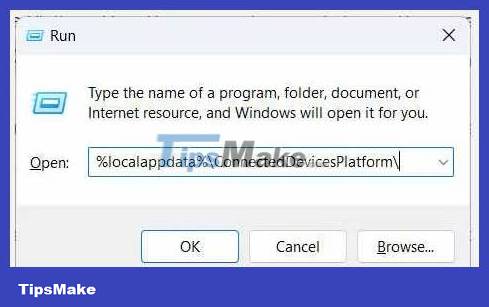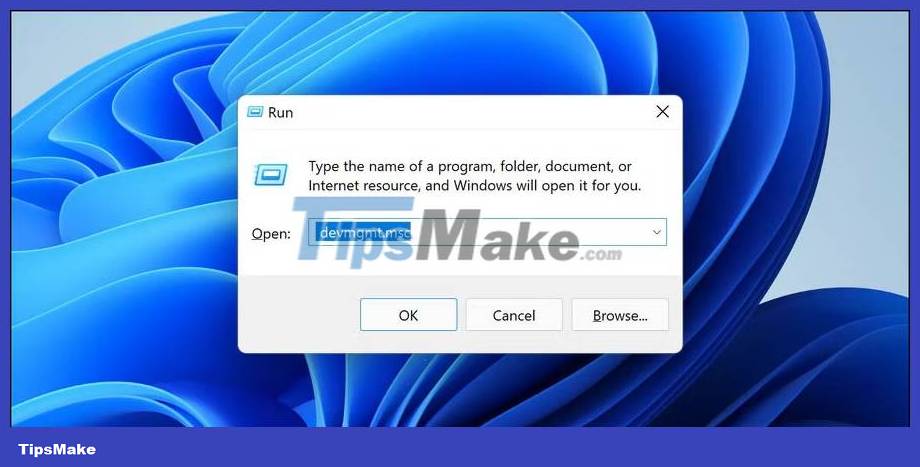How to fix 'Connected Devices Platform User' service error using up RAM on Windows
Each time Windows starts, the Connected Devices Platform User service will upload the necessary data needed by the connected devices on your computer. It also authenticates and facilitates communication between them.
When it consumes too much RAM, it means there could be a problem with the process or your connected devices. The article below will show you how to prevent the Connected Devices Platform User service from taking up your physical memory.
1. Disable the Connected Devices Platform User service
The simplest way to prevent the Connected Devices Platform User service from using too much RAM is to turn it off. However, this may cause some unwanted behavior on your computer. And if that happens, you can always re-enable the service.
To turn off the Connected Devices Platform User service, press Win + R to display Windows Run. Type services.msc in the text box and then press the Enter key on your keyboard.

Find Disable Connected Devices Platform User Service in the service list and double-click the service. Click the Startup type drop-down menu and select Disabled . Then, under Service status in the same window, click Stop.

Now, check Task Manager to see if the service is still consuming too much RAM.
2. Delete the ActivitiesCache.db file
Some users have reported that deleting the ActivitiesCache.db file on their computer helped resolve the issue. To remove it, start by disabling the Connected Devices Platform User service, as discussed above. Then, press Win + R to open Windows Run, copy and paste %localappdata%ConnectedDevicesPlatform into the text box, and then press the Enter key.

This will open the ConnectedDevicesPlatform folder. You will see several files and folders in there, so open each folder and delete the ActivitiesCache.db file in all of them.

Once done, restart your computer and see if the Connected Devices Platform User service is still causing RAM consumption issues.
3. Check for problems with computer hardware
Sometimes, the problem can arise because one of your connected devices has a problem. To check if your connected devices are working properly, open Device Manager by pressing Win + R , typing devmgmt.msc in the text box, then pressing the Enter key on the keyboard.

In Device Manager, double-click the device you suspect is causing the problem. This will open its properties window.
In the General tab of the Properties window , make sure it says This device is working properly in Device status.

Otherwise, you'll see an error message and accompanying code. Make a note of both so you can start troubleshooting. You can start by using one of the Windows troubleshooters to check and fix the hardware problem you're experiencing.
If all of the above steps don't work, you may need to use a system restore point that you created before your system started using too much RAM. And if that doesn't work either, you may have to reset your Windows computer.
You should read it
- Manufacturer - User - Customer - who are they?
- How to find devices connected to the network using Debian
- How to See Who's Connected to Your Wi Fi
- Google released Android Things 1.0 for IoT devices
- How to view and delete devices that are connected to your AppleID account
- How to Use iMessage
- What is Uno Platform?
- The wizard chooses the development platform for the application - Application Development Platform
May be interested
- The 'Connected With Limited Access' error in Windows
 when setting up or using a windows computer network, the connected with limited access error message may appear for several reasons.
when setting up or using a windows computer network, the connected with limited access error message may appear for several reasons. - How to fix VPN error 619
 one of the most common problems commonly encountered when working with a virtual private network on a windows platform is a vpn error 619 - a connection to the remote computer could not be established with some old vpn servers, the error message will displays the port was disconnected instead.
one of the most common problems commonly encountered when working with a virtual private network on a windows platform is a vpn error 619 - a connection to the remote computer could not be established with some old vpn servers, the error message will displays the port was disconnected instead. - How to find devices connected to the network using Debian
 sometimes you need to find out which device is connected to your network. in this article, tipsmake.com will describe how to install and use nmap to find devices connected to your network.
sometimes you need to find out which device is connected to your network. in this article, tipsmake.com will describe how to install and use nmap to find devices connected to your network. - Summary of several ways to fix No Service errors on iPhone
 occasionally in some cases, iphone users often encounter no service error, no sim card. there are many causes of errors, probably because you inserted sim card incorrectly or software error, .... to fix this error, please refer to the following article of network administrator.
occasionally in some cases, iphone users often encounter no service error, no sim card. there are many causes of errors, probably because you inserted sim card incorrectly or software error, .... to fix this error, please refer to the following article of network administrator. - How to fix offline errors of printers on Windows 10
 the computer's offline printer error is a frequent error, even if the user has turned on the device and connected the printer to the computer.
the computer's offline printer error is a frequent error, even if the user has turned on the device and connected the printer to the computer. - How to fix 'This App Can't Run on Your PC' error on Windows 10
 if windows 10 shows the 'this app can't run on your pc' error, there could be a few reasons behind this problem. sometimes the application is not compatible with your system, you are logged in with the wrong user account or the settings are faulty.
if windows 10 shows the 'this app can't run on your pc' error, there could be a few reasons behind this problem. sometimes the application is not compatible with your system, you are logged in with the wrong user account or the settings are faulty. - How to See Who's Connected to Your Wi Fi
 do you suspect someone has accessed your wi-fi? if you want to know which devices are connecting to your wi-fi, you've come to the right place. there are many ways to help you find information! this article will guide you to check who has connected to your wi-fi.
do you suspect someone has accessed your wi-fi? if you want to know which devices are connecting to your wi-fi, you've come to the right place. there are many ways to help you find information! this article will guide you to check who has connected to your wi-fi. - Outlook 701 error: 'The Service is Currently Offline' on the Android device, here's how to fix it
 during the reconfiguration of the outlook account, some users reflect that on the screen the error is displayed the service is currently offline. attached the error message: 'unable to log-in. service is currently offline.
during the reconfiguration of the outlook account, some users reflect that on the screen the error is displayed the service is currently offline. attached the error message: 'unable to log-in. service is currently offline. - What to do when the error 'iPhone cannot be synced' during data synchronization on iTunes?
 iphone cannot be synced error occurs mainly on ios 7 and ios 8 devices. this error occurs on itunes, while connecting your ios device to mac via itunes. the cause of the error is an error of connection problems, problem connected devices.
iphone cannot be synced error occurs mainly on ios 7 and ios 8 devices. this error occurs on itunes, while connecting your ios device to mac via itunes. the cause of the error is an error of connection problems, problem connected devices. - Google released Android Things 1.0 for IoT devices
 on may 7, google officially launched android things 1.0, the platform works on iot devices such as smart speakers, internet-connected security cameras ...
on may 7, google officially launched android things 1.0, the platform works on iot devices such as smart speakers, internet-connected security cameras ...










 Microsoft is developing a genuine 'garbage removal' tool for Windows
Microsoft is developing a genuine 'garbage removal' tool for Windows How to download and install Llama 2 locally
How to download and install Llama 2 locally How to run VM on Raspberry Pi using Proxmox
How to run VM on Raspberry Pi using Proxmox Windows 10 only has 2 more years of support left
Windows 10 only has 2 more years of support left How to enable two-sided printing on Windows
How to enable two-sided printing on Windows How to fix webcam error displaying black screen on Windows
How to fix webcam error displaying black screen on Windows